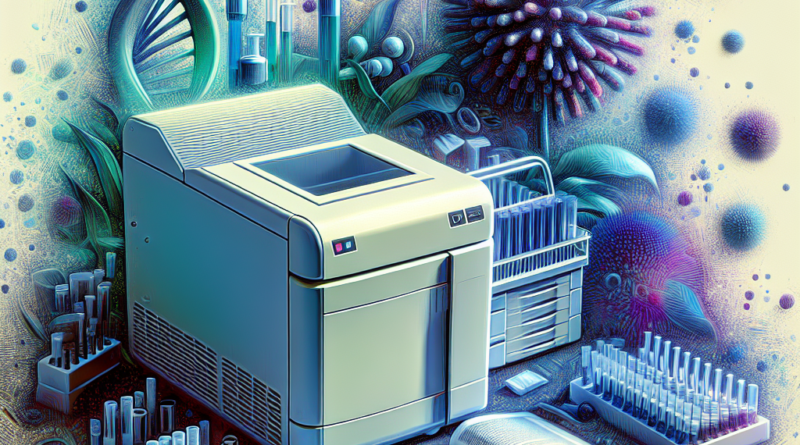Enhancing Bioaerosol Monitoring: The Sensitivity and Environmental Interference of PCR Detection
Understanding the Science Behind PCR for Airborne Microorganism Detection
As we delve into the fascinating world of microbial detection, it’s essential to understand the tools and techniques that scientists use to uncover the invisible inhabitants of our air. One such tool is the Polymerase Chain Reaction (PCR), a revolutionary method that amplifies tiny amounts of DNA to detectable levels. Before we explore the study at hand, let’s establish a foundation of knowledge about PCR and its significance in the field of aerobiology.
The Basics of PCR
PCR is a technique that allows for the amplification of a specific DNA sequence from a small sample, making it possible to study the genetic material in detail. This is particularly useful when the quantity of DNA present is minuscule, such as in the case of airborne microorganisms. PCR consists of three main steps: denaturation, annealing, and extension, which are repeated in cycles to exponentially increase the amount of targeted DNA.
Importance of Airborne Microorganism Monitoring
Airborne microorganisms, or bioaerosols, can pose significant health risks, ranging from allergies to infectious diseases. Monitoring these organisms is crucial for public health, especially in environments like hospitals, wastewater treatment facilities, and agricultural sites. Traditional methods for detecting airborne microorganisms, such as culture techniques, often fall short due to their time-consuming nature and inability to detect non-culturable organisms. PCR offers a rapid and sensitive alternative for bioaerosol monitoring.
Results of the Study on PCR Assay Sensitivity
Advancing Techniques for Microbial Detection
In the study conducted by Alvarez et al. (1995), the sensitivity of PCR for detecting Escherichia coli DH1 in airborne samples was thoroughly assessed. The researchers used AGI-30 samplers to collect air samples and then applied PCR techniques to detect the presence of the target organism.
Cell Lysis Methods and Sensitivity
The study compared two cell lysis methods: freeze-thaw and solid-phase. The freeze-thaw method demonstrated the ability to detect a single bacterial cell within 5 hours, while the solid-phase method required 9 hours. The sensitivity of the solid-phase method was 10-fold lower than the freeze-thaw when genomic targets were used.
Environmental Interference and PCR Efficacy
Environmental bioaerosols can inhibit PCR, leading to false-negative results. The study found that samples with 103 to 104 CFU of environmental organisms per m3 could inhibit amplification. However, a 1/10 dilution of these samples restored successful amplification, indicating that PCR could be adapted to overcome environmental interferences.
Field Validation and Detection Limits
Field validation of the PCR protocol confirmed the presence of airborne E. coli and/or Shigella spp. in outdoor samples. The study’s PCR method achieved a detection limit corresponding to approximately one bacterial cell per seeded sample, even in the presence of high airborne microorganism concentrations.
Impact and Future Prospects of PCR in Air Quality Monitoring
Implications for Public Health and Industry
The implications of this study are significant for public health and various industries. The ability to rapidly detect low concentrations of airborne microorganisms can improve response times to potential bioaerosol threats, enhance environmental monitoring, and inform public health strategies.
Advantages of PCR over Traditional Methods
PCR offers several advantages over traditional culture-based methods, including speed, sensitivity, and the ability to detect non-culturable organisms. This study demonstrates that PCR can detect as little as one organism per m3, which is a level of sensitivity that culture methods may not achieve.
Future Directions for Research
While this study provides a solid foundation, future research could focus on quantifying airborne pathogens, exploring alternative collection methods, and distinguishing between living and dead organisms. PCR could also be adapted to detect a wider array of microorganisms, including viruses, fungi, and parasites.
Concluding Thoughts on PCR for Bioaerosol Monitoring
In conclusion, PCR is a powerful tool for the detection of airborne microorganisms. The study by Alvarez et al. (1995) is a testament to the method’s potential in air quality monitoring. As we continue to refine these techniques, we can expect PCR to play an increasingly vital role in safeguarding our health and environment.
Reference
Alvarez, A. J., Buttner, M. P., & Stetzenbach, L. D. (1995). PCR for bioaerosol monitoring: sensitivity and environmental interference. Applied and Environmental Microbiology, 61(10), 3639-3644. http://dx.doi.org/10.1128/aem.61.10.3639-3644.1995




